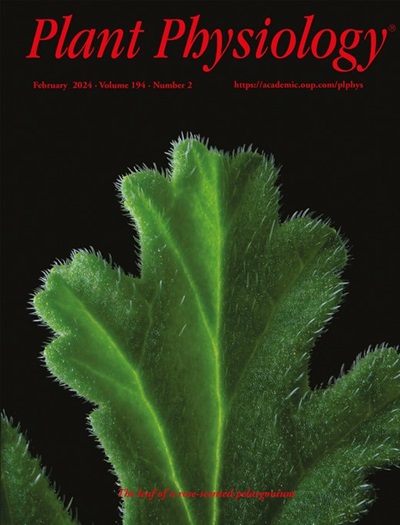高温条件下的植物碳水化合物亚细胞代谢
IF 6.5
1区 生物学
Q1 PLANT SCIENCES
引用次数: 0
摘要
本文章由计算机程序翻译,如有差异,请以英文原文为准。
Subcellular plant carbohydrate metabolism under elevated temperature
In many plant species, exposure to a changing environmental temperature regime induces an acclimation response that ultimately increases thermotolerance. Under elevated temperature, membrane systems undergo remodeling to counteract destabilizing thermodynamic effects. Elevated temperature also affects photosynthesis and carbohydrate metabolism due to altered protein functions, enzyme activities, and transport across membrane systems. Here, a combination of electrolyte leakage assays and chlorophyll fluorescence measurements was applied to quantify heat tolerance before and after heat acclimation in Arabidopsis thaliana under different temperature regimes. Subcellular carbohydrate concentrations were determined through non-aqueous fractionation and 3D reconstruction of mesophyll cells and subcellular compartments using serial block-face scanning electron microscopy. Across temperature regimes between 32 °C and 38 °C, seven days of heat acclimation at 34 °C most efficiently increased tissue heat tolerance. Under such conditions, cytosolic sucrose concentrations were stabilized by a shift in sucrose cleavage rates into the vacuolar compartment, while invertase-driven cytosolic sucrose cleavage was efficiently quenched by fructose and glucose acting as competitive and non-competitive inhibitors, respectively. Finally, this study provides strong evidence for a sucrose concentration gradient from the cytosol into the vacuole, which might directly affect the physiological role and direction of sugar transport across cellular membrane systems.
求助全文
通过发布文献求助,成功后即可免费获取论文全文。
去求助
来源期刊

Plant Physiology
生物-植物科学
CiteScore
12.20
自引率
5.40%
发文量
535
审稿时长
2.3 months
期刊介绍:
Plant Physiology® is a distinguished and highly respected journal with a rich history dating back to its establishment in 1926. It stands as a leading international publication in the field of plant biology, covering a comprehensive range of topics from the molecular and structural aspects of plant life to systems biology and ecophysiology. Recognized as the most highly cited journal in plant sciences, Plant Physiology® is a testament to its commitment to excellence and the dissemination of groundbreaking research.
As the official publication of the American Society of Plant Biologists, Plant Physiology® upholds rigorous peer-review standards, ensuring that the scientific community receives the highest quality research. The journal releases 12 issues annually, providing a steady stream of new findings and insights to its readership.
 求助内容:
求助内容: 应助结果提醒方式:
应助结果提醒方式:


